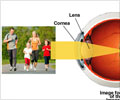Inspired by the human anatomy, researchers in the United States have created the world's first curved electronic "eye" camera, according to a study released Wednesday.
The size and shape of a human eye, the device weaves a network of silicon detectors into a flexible mesh, and could usher in a new generation of distortion-free digital and video cameras.Experiments already under way are testing other potential applications, including a thin, pliable monitor to detect electrical signals travelling across the undulating surface of the human brain.
Its breakthrough design also points the way to the development of artificial electronic retinas that could one day help restore sight, says the study, published in the British journal Nature.
"This approach allows us to put electronics in places where we couldn't before," said John Rogers, an engineer at the University of Illinois, who led the research along with Yonggang Huang of Northwestern University.
"We can now, for the first time, move device design beyond the flatland constraint of conventional wafer-based systems."
A curved array of detectors is "much better suited for use as retinal implants," Rogers said in a statement.
Advertisement
Engineers have been trying for decades to manufacture an electronic eye system, but the goal of creating a working camera remained elusive.
Advertisement
Conventional sensors cannot bend without damaging light-sensitive pixels -- the semiconductor wafers in which they are embedded are rigid and brittle, fracturing at strains of less than one percent.
Rogers and Huang overcame these limitations by linking the fragile light-sensitive pixels with tiny, flexible wires which can bend by as much a 40 percent.
This electronic mesh was fitted against a rubber membrane stretched into the curved shape of a retina, and then transferred to a hemispherical glass dome of the same shape, creating the camera lens.
"This research is truly transformative," said Ken Chong, an advisor in the National Science Foundation Engineering Directorate, which funded the study.
"Using simple mechanics principles, the researchers have produced, for the first time, electronic devices on a hemispherical surface so that they can take images much like those captured by the human eye," he said in a statement.
In a commentary, also published in Nature, Takao Someya of the University of Tokyo said the new technology "heralds the advent of new classes of imaging devices with wide-angle fields of view, low distortion and compact size."
Source-AFP
SRM









